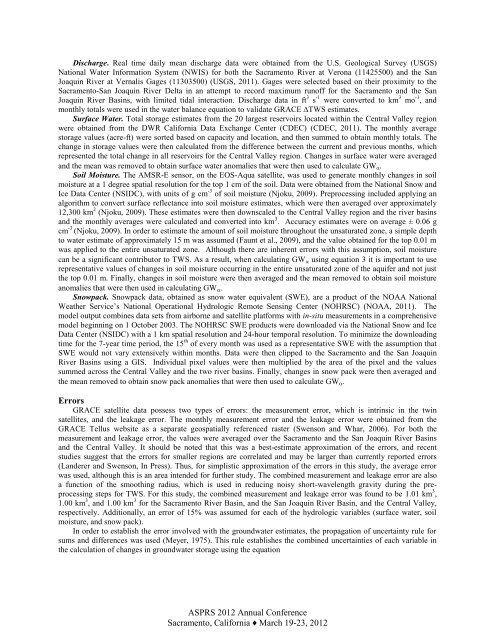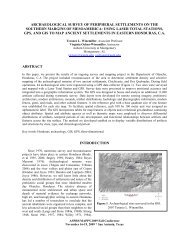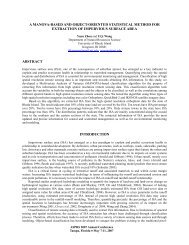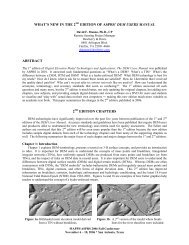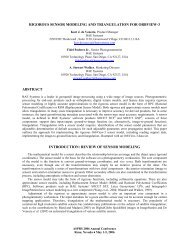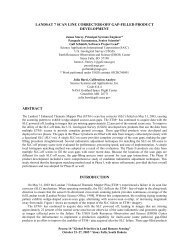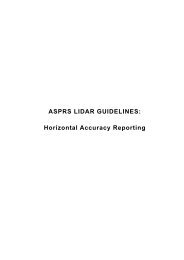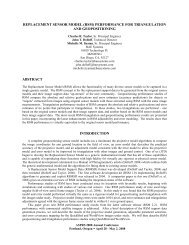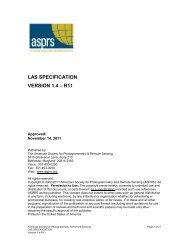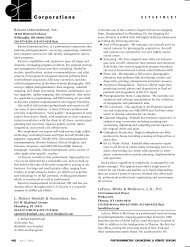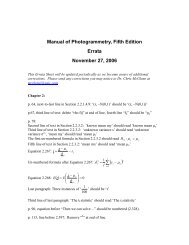comparison of changes in groundwater storage using grace ... - asprs
comparison of changes in groundwater storage using grace ... - asprs
comparison of changes in groundwater storage using grace ... - asprs
Create successful ePaper yourself
Turn your PDF publications into a flip-book with our unique Google optimized e-Paper software.
Discharge. Real time daily mean discharge data were obta<strong>in</strong>ed from the U.S. Geological Survey (USGS)<br />
National Water Information System (NWIS) for both the Sacramento River at Verona (11425500) and the San<br />
Joaqu<strong>in</strong> River at Vernalis Gages (11303500) (USGS, 2011). Gages were selected based on their proximity to the<br />
Sacramento-San Joaqu<strong>in</strong> River Delta <strong>in</strong> an attempt to record maximum run<strong>of</strong>f for the Sacramento and the San<br />
Joaqu<strong>in</strong> River Bas<strong>in</strong>s, with limited tidal <strong>in</strong>teraction. Discharge data <strong>in</strong> ft 3 s -1 were converted to km 3 mo -1 , and<br />
monthly totals were used <strong>in</strong> the water balance equation to validate GRACE ∆TWS estimates.<br />
Surface Water. Total <strong>storage</strong> estimates from the 20 largest reservoirs located with<strong>in</strong> the Central Valley region<br />
were obta<strong>in</strong>ed from the DWR California Data Exchange Center (CDEC) (CDEC, 2011). The monthly average<br />
<strong>storage</strong> values (acre-ft) were sorted based on capacity and location, and then summed to obta<strong>in</strong> monthly totals. The<br />
change <strong>in</strong> <strong>storage</strong> values were then calculated from the difference between the current and previous months, which<br />
represented the total change <strong>in</strong> all reservoirs for the Central Valley region. Changes <strong>in</strong> surface water were averaged<br />
and the mean was removed to obta<strong>in</strong> surface water anomalies that were then used to calculate GW .<br />
Soil Moisture. The AMSR-E sensor, on the EOS-Aqua satellite, was used to generate monthly <strong>changes</strong> <strong>in</strong> soil<br />
moisture at a 1 degree spatial resolution for the top 1 cm <strong>of</strong> the soil. Data were obta<strong>in</strong>ed from the National Snow and<br />
Ice Data Center (NSIDC), with units <strong>of</strong> g cm -3 <strong>of</strong> soil moisture (Njoku, 2009). Preprocess<strong>in</strong>g <strong>in</strong>cluded apply<strong>in</strong>g an<br />
algorithm to convert surface reflectance <strong>in</strong>to soil moisture estimates, which were then averaged over approximately<br />
12,300 km 2 (Njoku, 2009). These estimates were then downscaled to the Central Valley region and the river bas<strong>in</strong>s<br />
and the monthly averages were calculated and converted <strong>in</strong>to km 3 . Accuracy estimates were on average ± 0.06 g<br />
cm -3 (Njoku, 2009). In order to estimate the amount <strong>of</strong> soil moisture throughout the unsaturated zone, a simple depth<br />
to water estimate <strong>of</strong> approximately 15 m was assumed (Faunt et al., 2009), and the value obta<strong>in</strong>ed for the top 0.01 m<br />
was applied to the entire unsaturated zone. Although there are <strong>in</strong>herent errors with this assumption, soil moisture<br />
can be a significant contributor to TWS. As a result, when calculat<strong>in</strong>g GW us<strong>in</strong>g equation 3 it is important to use<br />
representative values <strong>of</strong> <strong>changes</strong> <strong>in</strong> soil moisture occurr<strong>in</strong>g <strong>in</strong> the entire unsaturated zone <strong>of</strong> the aquifer and not just<br />
the top 0.01 m. F<strong>in</strong>ally, <strong>changes</strong> <strong>in</strong> soil moisture were then averaged and the mean removed to obta<strong>in</strong> soil moisture<br />
anomalies that were then used <strong>in</strong> calculat<strong>in</strong>g GW .<br />
Snowpack. Snowpack data, obta<strong>in</strong>ed as snow water equivalent (SWE), are a product <strong>of</strong> the NOAA National<br />
Weather Service’s National Operational Hydrologic Remote Sens<strong>in</strong>g Center (NOHRSC) (NOAA, 2011). The<br />
model output comb<strong>in</strong>es data sets from airborne and satellite platforms with <strong>in</strong>-situ measurements <strong>in</strong> a comprehensive<br />
model beg<strong>in</strong>n<strong>in</strong>g on 1 October 2003. The NOHRSC SWE products were downloaded via the National Snow and Ice<br />
Data Center (NSIDC) with a 1 km spatial resolution and 24-hour temporal resolution. To m<strong>in</strong>imize the download<strong>in</strong>g<br />
time for the 7-year time period, the 15 th <strong>of</strong> every month was used as a representative SWE with the assumption that<br />
SWE would not vary extensively with<strong>in</strong> months. Data were then clipped to the Sacramento and the San Joaqu<strong>in</strong><br />
River Bas<strong>in</strong>s us<strong>in</strong>g a GIS. Individual pixel values were then multiplied by the area <strong>of</strong> the pixel and the values<br />
summed across the Central Valley and the two river bas<strong>in</strong>s. F<strong>in</strong>ally, <strong>changes</strong> <strong>in</strong> snow pack were then averaged and<br />
the mean removed to obta<strong>in</strong> snow pack anomalies that were then used to calculate GW .<br />
Errors<br />
GRACE satellite data possess two types <strong>of</strong> errors: the measurement error, which is <strong>in</strong>tr<strong>in</strong>sic <strong>in</strong> the tw<strong>in</strong><br />
satellites, and the leakage error. The monthly measurement error and the leakage error were obta<strong>in</strong>ed from the<br />
GRACE Tellus website as a separate geospatially referenced raster (Swenson and Whar, 2006). For both the<br />
measurement and leakage error, the values were averaged over the Sacramento and the San Joaqu<strong>in</strong> River Bas<strong>in</strong>s<br />
and the Central Valley. It should be noted that this was a best-estimate approximation <strong>of</strong> the errors, and recent<br />
studies suggest that the errors for smaller regions are correlated and may be larger than currently reported errors<br />
(Landerer and Swenson, In Press). Thus, for simplistic approximation <strong>of</strong> the errors <strong>in</strong> this study, the average error<br />
was used, although this is an area <strong>in</strong>tended for further study. The comb<strong>in</strong>ed measurement and leakage error are also<br />
a function <strong>of</strong> the smooth<strong>in</strong>g radius, which is used <strong>in</strong> reduc<strong>in</strong>g noisy short-wavelength gravity dur<strong>in</strong>g the preprocess<strong>in</strong>g<br />
steps for TWS. For this study, the comb<strong>in</strong>ed measurement and leakage error was found to be 1.01 km 3 ,<br />
1.00 km 3 , and 1.00 km 3 for the Sacramento River Bas<strong>in</strong>, and the San Joaqu<strong>in</strong> River Bas<strong>in</strong>, and the Central Valley,<br />
respectively. Additionally, an error <strong>of</strong> 15% was assumed for each <strong>of</strong> the hydrologic variables (surface water, soil<br />
moisture, and snow pack).<br />
In order to establish the error <strong>in</strong>volved with the <strong>groundwater</strong> estimates, the propagation <strong>of</strong> uncerta<strong>in</strong>ty rule for<br />
sums and differences was used (Meyer, 1975). This rule establishes the comb<strong>in</strong>ed uncerta<strong>in</strong>ties <strong>of</strong> each variable <strong>in</strong><br />
the calculation <strong>of</strong> <strong>changes</strong> <strong>in</strong> <strong>groundwater</strong> <strong>storage</strong> us<strong>in</strong>g the equation<br />
ASPRS 2012 Annual Conference<br />
Sacramento, California ♦ March 19-23, 2012


